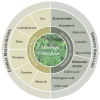Incorporation of Moringa oleifera Leaf Extract in Yoghurts to Mitigate Children's Malnutrition in Developing Countries
- PMID: 36985498
- PMCID: PMC10058877
- DOI: 10.3390/molecules28062526
Incorporation of Moringa oleifera Leaf Extract in Yoghurts to Mitigate Children's Malnutrition in Developing Countries
Abstract
Moringa oleifera, which is rich in bioactive compounds, has numerous biological activities and is a powerful source of antioxidants and nutrients. Therefore, M. oleifera can be incorporated into food to mitigate children's malnutrition. In this work, the bioactive compounds were extracted from M. oleifera leaf powder by ultrasound-assisted solid-liquid extraction. The antioxidant and antimicrobial activities and the phenolic composition of the extract were evaluated. The extract presented a total phenolic content of 54.5 ± 16.8 mg gallic acid equivalents/g and IC50 values of 133.4 ± 12.3 mg/L for DPPH and 60.0 ± 9.9 mg/L for ABTS. Catechin, chlorogenic acid, and epicatechin were the main phenolics identified by HPLC-DAD. The obtained extract and M. oleifera leaf powder were incorporated into yoghurts and their physicochemical and biological properties were studied. The incorporation of M. oleifera did not impair the yoghurts' stability over eight weeks when compared to both negative and positive controls. The extract presented higher stability regarding syneresis but lower stability regarding TPC compared to the powder. Also, the fortified yoghurts presented higher antioxidant properties than the negative control. These findings highlight the potential use of M. oleifera powder and extract as natural additives to produce fortified foods that can be used in the mitigation of malnutrition.
Keywords: M. oleifera; antioxidant activity; bioactive compounds; functional foods; yoghurt.
Conflict of interest statement
The authors declare no conflict of interest.
Figures







Similar articles
-
Phytochemical composition, antioxidant potential, and insecticidal activity of Moringa oleifera extracts against Tribolium castaneum: a sustainable approach to pest management.BMC Plant Biol. 2025 May 2;25(1):579. doi: 10.1186/s12870-025-06626-3. BMC Plant Biol. 2025. PMID: 40316907 Free PMC article.
-
Phytochemical Analysis, Antimutagenic and Antiviral Activity of Moringa oleifera L. Leaf Infusion: In Vitro and In Silico Studies.Molecules. 2022 Jun 22;27(13):4017. doi: 10.3390/molecules27134017. Molecules. 2022. PMID: 35807260 Free PMC article.
-
Production and Evaluation of Set-Type Yoghurt Fortified with Chlorella vulgaris and Moringa oleifera Powder.Plant Foods Hum Nutr. 2024 Jun;79(2):531-538. doi: 10.1007/s11130-024-01194-7. Epub 2024 May 22. Plant Foods Hum Nutr. 2024. PMID: 38775982
-
Complementary Feeding Practices and Childhood Malnutrition in South Africa: The Potential of Moringa Oleifera Leaf Powder as a Fortificant: A Narrative Review.Nutrients. 2023 Apr 21;15(8):2011. doi: 10.3390/nu15082011. Nutrients. 2023. PMID: 37111230 Free PMC article. Review.
-
Review of the Safety and Efficacy of Moringa oleifera.Phytother Res. 2015 Jun;29(6):796-804. doi: 10.1002/ptr.5325. Epub 2015 Mar 24. Phytother Res. 2015. PMID: 25808883 Free PMC article. Review.
Cited by
-
Valorization of Moringa oleifera Lam.: Healthy green biomass for circular bioeconomy.Food Chem X. 2025 Mar 9;26:102358. doi: 10.1016/j.fochx.2025.102358. eCollection 2025 Feb. Food Chem X. 2025. PMID: 40129732 Free PMC article. Review.
-
Bioactive Compounds in Moringa oleifera: Mechanisms of Action, Focus on Their Anti-Inflammatory Properties.Plants (Basel). 2023 Dec 20;13(1):20. doi: 10.3390/plants13010020. Plants (Basel). 2023. PMID: 38202328 Free PMC article. Review.
-
Development, physicochemical, and sensory analysis of moringa oleifera l. powder added buffalo milk yoghurt with pharmacological potential.Sci Rep. 2025 Aug 27;15(1):31519. doi: 10.1038/s41598-025-17428-w. Sci Rep. 2025. PMID: 40858930 Free PMC article.
-
Elevating Cereal-Based Nutrition: Moringa oleifera Supplemented Bread and Biscuits.Antioxidants (Basel). 2023 Dec 1;12(12):2069. doi: 10.3390/antiox12122069. Antioxidants (Basel). 2023. PMID: 38136189 Free PMC article.
-
A Systematic Review of Extraction Methods, Phytochemicals, and Food Applications of Moringa oleifera Leaves Using PRISMA Methodology.Food Sci Nutr. 2025 Apr 28;13(4):e70138. doi: 10.1002/fsn3.70138. eCollection 2025 Apr. Food Sci Nutr. 2025. PMID: 40302917 Free PMC article. Review.
References
-
- Azlan U.K., Mediani A., Rohani E.R., Tong X., Han R., Misnan N.M., Jam F.A., Bunawan H., Sarian M.N., Hamezah H.S. A Comprehensive Review with Updated Future Perspectives on the Ethnomedicinal and Pharmacological Aspects of Moringa oleifera. Molecules. 2022;27:5765. doi: 10.3390/molecules27185765. - DOI - PMC - PubMed
-
- Panda S., Kar A., Sharma P., Sharma A. Cardioprotective potential of N,α-l-rhamnopyranosyl vincosamide, an indole alkaloid, isolated from the leaves of Moringa oleifera in isoproterenol induced cardiotoxic rats: In vivo and in vitro studies. Bioorg. Med. Chem. Lett. 2013;23:959–962. doi: 10.1016/j.bmcl.2012.12.060. - DOI - PubMed
-
- Arulselvan P., Tan W.S., Gothai S., Muniandy K., Fakurazi S., Esa N.M., Alarfaj A.A., Kumar S.S. Anti-Inflammatory Potential of Ethyl Acetate Fraction of Moringa oleifera in Downregulating the NF-κB Signaling Pathway in Lipopolysaccharide-Stimulated Macrophages. Molecules. 2016;21:1452. doi: 10.3390/molecules21111452. - DOI - PMC - PubMed
MeSH terms
Substances
LinkOut - more resources
Full Text Sources
Medical

